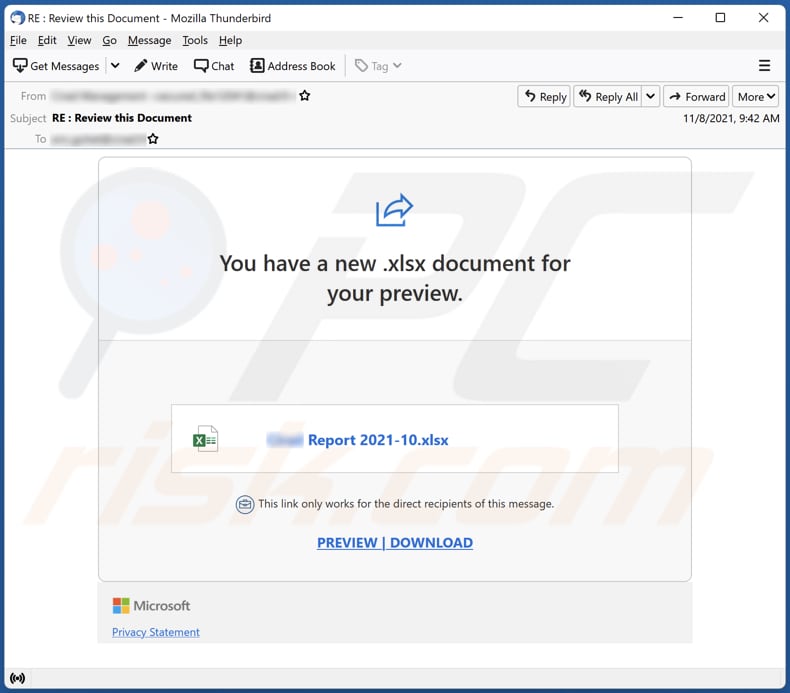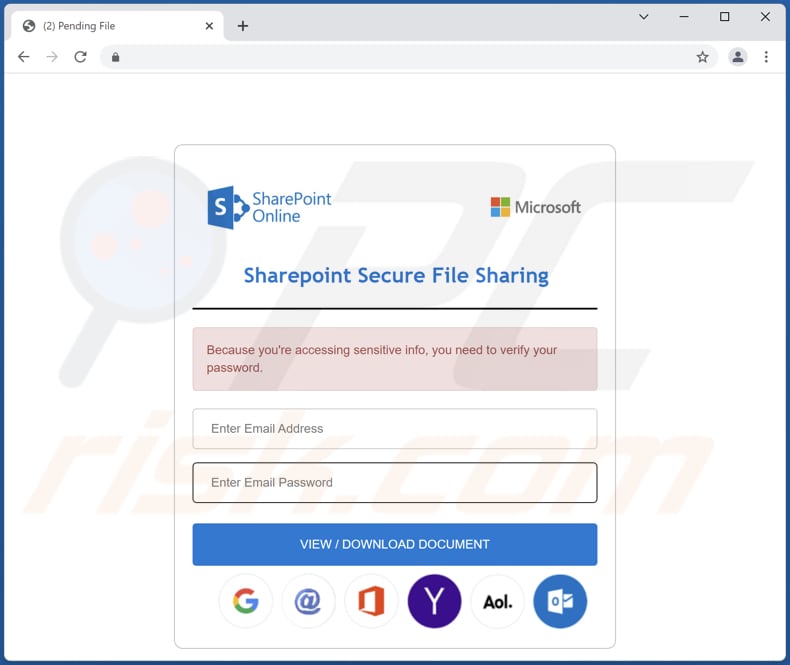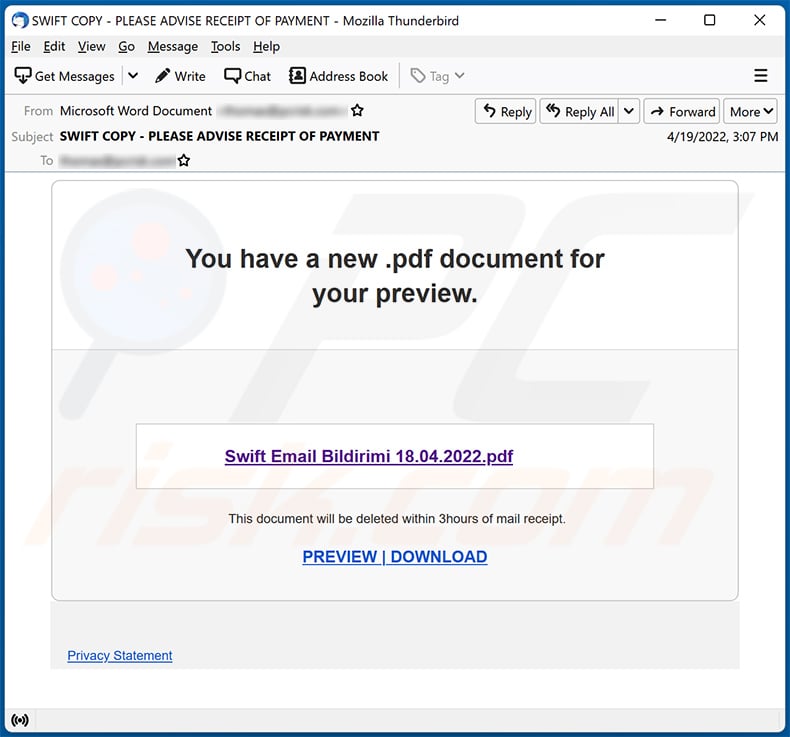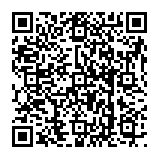How to recognize scams like .xlsx document for your preview email scam?
![]() Written by Tomas Meskauskas on (updated)
Written by Tomas Meskauskas on (updated)
What is the .xlsx document for your preview email scam?
Phishing emails are disguised as letters from legitimate companies, organizations, or other entities. A big part of these emails is used to extract login credentials (like usernames, passwords), credit card details, or similar information from unsuspecting recipients. In this case, scammers attempt to obtain email login credentials.

.xlsx document for your preview email scam in detail
Scammers behind this phishing email encourage recipients to click the provided website link to download and review a document presented as some monthly report. The link in this email opens a fake SharePoint login website asking to enter an email address and password.
It is likely that scammers would use the provided information to hijack Office 365 accounts. They could also try to use the same login credentials to access other accounts (for example, social media, email accounts).
| Name | (.)xlsx Document For your Preview Email Scam |
| Threat Type | Phishing, Scam, Social Engineering, Fraud |
| Fake Claim | The provided hyperlink is a download link for a document regarding monthly report |
| Symptoms | Unauthorized online purchases, changed online account passwords, identity theft, illegal access of the computer. |
| Distribution methods | Deceptive emails, rogue online pop-up ads, search engine poisoning techniques, misspelled domains. |
| Damage | Loss of sensitive private information, monetary loss, identity theft. |
| Malware Removal (Windows) | To eliminate possible malware infections, scan your computer with legitimate antivirus software. Our security researchers recommend using Combo Cleaner. |
Phishing emails in general
The majority of phishing emails are disguised as important, official letters from legitimate, existing entities. It is common for them to contain some website link designed to open a deceptive page. More examples of similar emails are "Download The Pending Mails Manually", "HP ePrint". It is important to know that emails can be malicious.
How do malicious emails lead to computer infections?
Emails used to deliver malware contain malicious attachments or website links. The purpose of these emails is to trick recipients into opening malicious files (for example, JavaScript files, executable files, PDF or MS Office documents). Not all malicious files infect computers right after they are opened.
Malicious documents do not infect computers unless users enable macros commands (editing or content). It is important to know that this does not apply to documents opened with MS Office versions released before 2010. Those versions do not have the "Protected View" mode.
How to avoid installation of malware?
Do not trust irrelevant emails that come from unknown addresses. Especially if they contain attachments or website links. Their contents can be malicious. Use only official websites and direct links as sources for downloading files, programs. Update and activate installed programs using tools provided by their official developers.
Have a reliable antivirus or other security software installed on a computer and run scans with it regularly. If you've already opened malicious attachments, we recommend running a scan with Combo Cleaner Antivirus for Windows to automatically eliminate infiltrated malware.
Text presented in the .xlsx document for your preview email scam:
Subject: RE : Review this Document
You have a new .xlsx document for your preview.
- Report 2021-10.xlsx
This link only works for the direct recipients of this message.
PREVIEW | DOWNLOAD
Privacy Statement
Screenshot of the fake SharePoint login page:

Another example of document for your preview-themed spam email used to promote a phishing site:

Text presented within:
Subject: SWIFT COPY - PLEASE ADVISE RECEIPT OF PAYMENT
You have a new .pdf document for your preview.
Swift Email Bildirimi 18.04.2022.pdf
This document will be deleted within 3hours of mail receipt.
PREVIEW | DOWNLOAD
Privacy Statement
Instant automatic malware removal:
Manual threat removal might be a lengthy and complicated process that requires advanced IT skills. Combo Cleaner is a professional automatic malware removal tool that is recommended to get rid of malware. Download it by clicking the button below:
▼ DOWNLOAD Combo Cleaner
By downloading any software listed on this website you agree to our Privacy Policy and Terms of Use. To use full-featured product, you have to purchase a license for Combo Cleaner. 7 days free trial available. Combo Cleaner is owned and operated by Rcs Lt, the parent company of PCRisk.com read more.
Quick menu:
- What is .xlsx Document For Your Preview spam?
- Types of malicious emails.
- How to spot a malicious email?
- What to do if you fell for an email scam?
Types of malicious emails:
![]() Phishing Emails
Phishing Emails
Most commonly, cybercriminals use deceptive emails to trick Internet users into giving away their sensitive private information, for example, login information for various online services, email accounts, or online banking information.
Such attacks are called phishing. In a phishing attack, cybercriminals usually send an email message with some popular service logo (for example, Microsoft, DHL, Amazon, Netflix), create urgency (wrong shipping address, expired password, etc.), and place a link which they hope their potential victims will click on.
After clicking the link presented in such email message, victims are redirected to a fake website that looks identical or extremely similar to the original one. Victims are then asked to enter their password, credit card details, or some other information that gets stolen by cybercriminals.
![]() Emails with Malicious Attachments
Emails with Malicious Attachments
Another popular attack vector is email spam with malicious attachments that infect users' computers with malware. Malicious attachments usually carry trojans that are capable of stealing passwords, banking information, and other sensitive information.
In such attacks, cybercriminals' main goal is to trick their potential victims into opening an infected email attachment. To achieve this goal, email messages usually talk about recently received invoices, faxes, or voice messages.
If a potential victim falls for the lure and opens the attachment, their computers get infected, and cybercriminals can collect a lot of sensitive information.
While it's a more complicated method to steal personal information (spam filters and antivirus programs usually detect such attempts), if successful, cybercriminals can get a much wider array of data and can collect information for a long period of time.
![]() Sextortion Emails
Sextortion Emails
This is a type of phishing. In this case, users receive an email claiming that a cybercriminal could access the webcam of the potential victim and has a video recording of one's masturbation.
To get rid of the video, victims are asked to pay a ransom (usually using Bitcoin or another cryptocurrency). Nevertheless, all of these claims are false - users who receive such emails should ignore and delete them.
How to spot a malicious email?
While cyber criminals try to make their lure emails look trustworthy, here are some things that you should look for when trying to spot a phishing email:
- Check the sender's ("from") email address: Hover your mouse over the "from" address and check if it's legitimate. For example, if you received an email from Microsoft, be sure to check if the email address is @microsoft.com and not something suspicious like @m1crosoft.com, @microsfot.com, @account-security-noreply.com, etc.
- Check for generic greetings: If the greeting in the email is "Dear user", "Dear @youremail.com", "Dear valued customer", this should raise suspiciousness. Most commonly, companies call you by your name. Lack of this information could signal a phishing attempt.
- Check the links in the email: Hover your mouse over the link presented in the email, if the link that appears seems suspicious, don't click it. For example, if you received an email from Microsoft and the link in the email shows that it will go to firebasestorage.googleapis.com/v0... you shouldn't trust it. It's best not to click any links in the emails but to visit the company website that sent you the email in the first place.
- Don't blindly trust email attachments: Most commonly, legitimate companies will ask you to log in to their website and to view any documents there; if you received an email with an attachment, it's a good idea to scan it with an antivirus application. Infected email attachments are a common attack vector used by cybercriminals.
To minimise the risk of opening phishing and malicious emails we recommend using Combo Cleaner Antivirus for Windows.
Example of a spam email:

What to do if you fell for an email scam?
- If you clicked on a link in a phishing email and entered your password - be sure to change your password as soon as possible. Usually, cybercriminals collect stolen credentials and then sell them to other groups that use them for malicious purposes. If you change your password in a timely manner, there's a chance that criminals won't have enough time to do any damage.
- If you entered your credit card information - contact your bank as soon as possible and explain the situation. There's a good chance that you will need to cancel your compromised credit card and get a new one.
- If you see any signs of identity theft - you should immediately contact the Federal Trade Commission. This institution will collect information about your situation and create a personal recovery plan.
- If you opened a malicious attachment - your computer is probably infected, you should scan it with a reputable antivirus application. For this purpose, we recommend using Combo Cleaner Antivirus for Windows.
- Help other Internet users - report phishing emails to Anti-Phishing Working Group, FBI’s Internet Crime Complaint Center, National Fraud Information Center and U.S. Department of Justice.
Frequently Asked Questions (FAQ)
Why did I receive this email?
Scammers use emails in obtained databases to send the same email to all recipients. These emails are not personal (as a rule, scammers do not target anyone in particular).
I have provided my personal information when tricked by this email, what should I do?
If you have provided login credentials on the fake SharePoint login page (or any other phishing site), change all passwords as soon as possible.
I have read the email but did not open the link, is my personal information safe?
Opening an email by itself is completely harmless. Links or files in emails can lead to problems (including computer infections) only if they get opened.
Will Combo Cleaner remove malware infections that were present in email attachment?
Yes, Combo Cleaner is capable of detecting and eliminating almost all known malicious programs. It is recommended to scan the operating system using a full system scan because sophisticated malware can hide deep in the system.


▼ Show Discussion